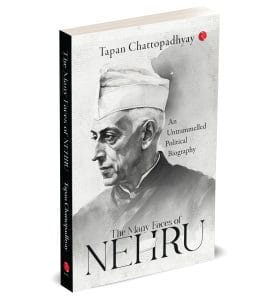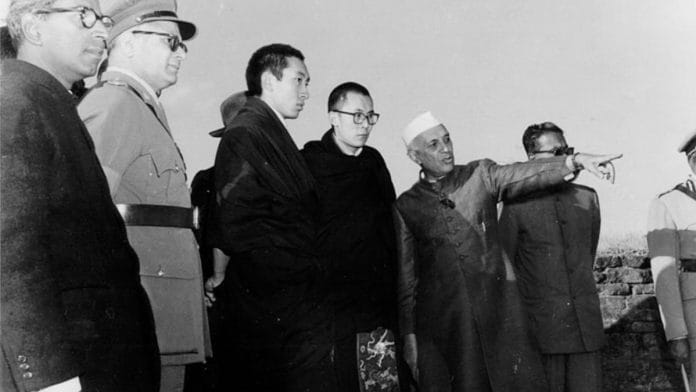Initially, after occupying Lhasa in 1951, the Chinese tried to win over Tibetan aristocrats by offering them gifts and money, even when the Tibetan Resistance was fighting the Red Army in the outlying areas. They also took some populist measures to woo the common man.
Very soon, however, the Chinese curtailed the powers of the Dalai Lama and those who were close to him, to prevent them from functioning independently. In such a situation, Gyalo Thondup, who had returned to Lhasa to help his younger brother, fled to Darjeeling, where he formed an underground movement to oppose the Chinese occupation of Tibet.
In April 1954, India withdrew the military escort and training posts from southern Tibet following the Sino-Indian Agreement. In September, the Dalai Lama visited Beijing at the PRC’s ‘request’. He was felicitated with full ceremonial honours by Zhou Enlai and Zhu De and stayed in China for seven months.
Back in Lhasa, he came to know about the bombardment of the Litang Monastery by the Chinese army, about the degrading abuse that the monks and nuns had to face in their hands, and finally, the torture and execution of the women and children whose husbands and fathers had joined the resistance movement.
In 1956, Gompo Tashi Andrugtsang (1905–64), a daredevil businessman from a highborn family, organized the common people of Kham and Amdo in guerrilla warfare against the Chinese. He heroically conducted a resistance movement almost entirely with the help of local resources, and as such, it can be easily compared with any other guerrilla movement in other parts of the world.
Subsequently, the CIA came into the picture at the initiative of the Dalai Lama’s brothers, Takster and Gyalo Thondup, for supplying funds and offering training to some Tibetan operatives in Camp Hale, Colorado. It also airdropped arms and ammunition inside Tibet. The CIA used an air base near Dhaka in East Pakistan, now Bangladesh, and thereafter another one at Charbatia, near Cuttack in India, for its airdropping operations. But without adequate planning and knowledge about the terrain, these were of little real use.
Throughout 1957, the Khampas and the Amdowas fought the Chinese occupation forces. Their activities met with increasingly repressive measures, which, in turn, sent a flow of refugees to central Tibet and transformed the local uprising near the border into a national insurrection.
In early 1958, Gompo secretly called a meeting of the resistance leaders in Lhasa and exhorted the chiefs of the two dozen Khampa and Amdowa groups, which constituted the Army of the National Defenders of the Faith, to unite in a nationwide resistance. His appeal succeeded and his effort got the support of Phala, the influential advisor of the Dalai Lama, who later organized the latter’s escape from Lhasa with the help of the CIA’s Special Activities Division.
Also read: Rani of Jhansi has no place in Manipuri culture, said a journalist. He was jailed for it
On 3 April 1959, Jawaharlal informed a cheering Parliament that the Dalai Lama and a party of eighty officials, members of his family and bodyguards had crossed into Indian territory three days earlier and they had been granted asylum.
P.N. Menon, the former Indian consul general in Lhasa, greeted the Dalai Lama at Bomdila in Arunachal Pradesh when he arrived there after a difficult ten-mile pony ride from the border. New Delhi had sent P.N. Menon to lay down the ground rules for the Tibetan ruler’s political activities in India.
P.N. Menon conveyed to the Dalai Lama that Jawaharlal was of the opinion that Tibet’s goal should be achieving internal autonomy and not independence. He also suggested that he only make a brief statement at his first press conference on Indian soil, mainly to give thanks to the Indian authorities for granting them asylum in India.
Upon hearing this, the young pontiff summarily rejected his counsel and reminded him that he had come to grief by following Jawaharlal’s advice in 1957. He made it clear that the Tibetans were fighting for complete independence and were determined to do so, regardless of the Indian government’s attitude. He would seek asylum elsewhere if the Indian government found his presence embarrassing.
When a shaken P.N. Menon cabled this to his ministry, he was told to let the Dalai Lama speak his mind with the exception of the issue of establishing a Tibetan government-in-exile that repudiated the seventeen-point agreement with the Chinese. He also could not mention the fact that he had sent three embarrassing letters to General Tan from the Norbulingka palace in Lhasa.
After further negotiation, the Dalai Lama agreed to issue a full statement of the grievances plaguing the ongoing Tibetan resistance as well as his own flight, choosing not to refer to a free Tibetan government and the embarrassing letters, and he did not specifically denounce the seventeen-point agreement. A week later, he issued a press statement in his name from Tezpur in Assam. It was on the Tibetan people’s strong desire for independence, but it did not demand that India should support it.
Jawaharlal met him on 24 April in Mussoorie, where the Dalai Lama was staying as the guest of G.D. Birla. They talked for over four hours, during which the Dalai Lama said that he had originally intended not to seek India’s hospitality but to establish his own government at Lhuntse Dzong in eastern Bhutan.
Later, he wrote in his autobiography that Jawaharlal was often impatient and irritated during their talks and ‘…banged the table…However, I went on in spite of the growing evidence that he could be a bit of a bully.’ The two leaders were unable to reconcile their views. Jawaharlal’s policy was to work towards restoring Tibet’s autonomy, while the Dalai Lama remained adamant about independence.
Subsequently, the CIA launched a few half-hearted operations for some time, assisted by the Indian intelligence, and then stopped. According to a CIA official,
These missions caused almost more harm to the Tibetans than to the Chinese forces. Because the Americans did not want their assistance to be attributable, they took care not to supply US-manufactured equipment. Instead, they dropped only a few badly made bazookas and some ancient British rifles which had once been in general service throughout India and Pakistan and thus could not be traced to source in the event of capture. But the mishandling they received whilst being air-dropped rendered them almost useless.
In the days that followed, China sought to transform Tibet culturally and ethnically. Chinese men and women were forced to stay in Tibet and marry Tibetans so that their progeny became ethnically and culturally Chinese. Likewise, planned efforts were made to change or influence Tibet’s various social, cultural and political institutions surreptitiously.
In his travelogue, From Heaven Lake, Vikram Seth has drawn on his own experiences in Tibet to poignantly describe the flagrant violation of human rights there. He has also described the horrendous demographic and cultural miscegenation, systematically engineered by the Chinese government to obliterate the ancient nation.

This excerpt from ‘The Many Faces of Nehru’ by Tapan Chattopadhyay has been published with permission from Rupa Publications India.






